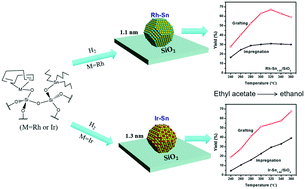Controllable synthesis of Ir(Rh)–Sn/SiO2 bimetallic catalysts via surface organometallic chemistry for the production of ethanol from hydrogenolysis of ethyl acetate†
Abstract
Ethanol as an alternative to traditional fossil fuels has recently attracted much attention all over the world, because ethanol is proven to be a clean, green and efficient fuel. Ethanol production from indirect syngas synthesis via the catalytic hydrogenolysis of esters has become one of the most competitive and sustainable routes. Ir–Sn and Rh–Sn bimetallic materials constitute the most effective catalysts for this reaction, because they exhibit high activity, selectivity and stability in the long-term reaction. A grafting approach based on the surface organometallic chemistry concept is developed for the synthesis of Ir(Rh)–Sn/SiO2 catalysts via the direct generation of Ir(Rh)–Sn bimetallic particles at the surface of SiO2. The formation of bimetallic particles at the surface of SiO2 was achieved by hydrogenolysis of the well-defined surface compounds ![[triple bond, length as m-dash]](https://www.rsc.org/images/entities/char_e002.gif) SiOIr(COD)/
SiOIr(COD)/![[triple bond, length as m-dash]](https://www.rsc.org/images/entities/char_e002.gif) SiOSnBu3 or
SiOSnBu3 or ![[triple bond, length as m-dash]](https://www.rsc.org/images/entities/char_e002.gif) SiORh(COD)/
SiORh(COD)/![[triple bond, length as m-dash]](https://www.rsc.org/images/entities/char_e002.gif) SiOSnBu3, which were obtained from sequential grafting of [(COD)IrCl]2 (or Rh(acac)(COD)) and HSnBu3 complexes at the surface of dehydroxylated SiO2. This molecular synthesis methodology enables in situ generation of Ir–Sn or Rh–Sn clusters at the surface of SiO2 under mild conditions, and affords highly dispersed Ir–Sn/SiO2 and Rh–Sn/SiO2 catalysts. The detailed structure of these two catalysts was systematically studied by STEM, XRD, N2 adsorption, CO-IR and XPS techniques, which reveal that the Ir–Sn and Rh–Sn particles of around 1.2 nm are homogeneously distributed at the surface of the SiO2. The Ir–Sn/SiO2 and Rh–Sn/SiO2 catalysts with a Sn/Ir(Rh) ratio of 1 show the best performance in the hydrogenolysis of ethyl acetate for the production of ethanol, which can deliver a selectivity to ethanol of up to 99%. Moreover, these two catalysts show excellent stability in the catalytic reaction, and their high conversion and selectivity can be completely kept for a long-term run of 120 hours.
SiOSnBu3, which were obtained from sequential grafting of [(COD)IrCl]2 (or Rh(acac)(COD)) and HSnBu3 complexes at the surface of dehydroxylated SiO2. This molecular synthesis methodology enables in situ generation of Ir–Sn or Rh–Sn clusters at the surface of SiO2 under mild conditions, and affords highly dispersed Ir–Sn/SiO2 and Rh–Sn/SiO2 catalysts. The detailed structure of these two catalysts was systematically studied by STEM, XRD, N2 adsorption, CO-IR and XPS techniques, which reveal that the Ir–Sn and Rh–Sn particles of around 1.2 nm are homogeneously distributed at the surface of the SiO2. The Ir–Sn/SiO2 and Rh–Sn/SiO2 catalysts with a Sn/Ir(Rh) ratio of 1 show the best performance in the hydrogenolysis of ethyl acetate for the production of ethanol, which can deliver a selectivity to ethanol of up to 99%. Moreover, these two catalysts show excellent stability in the catalytic reaction, and their high conversion and selectivity can be completely kept for a long-term run of 120 hours.



 Please wait while we load your content...
Please wait while we load your content...